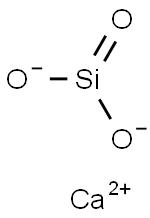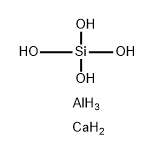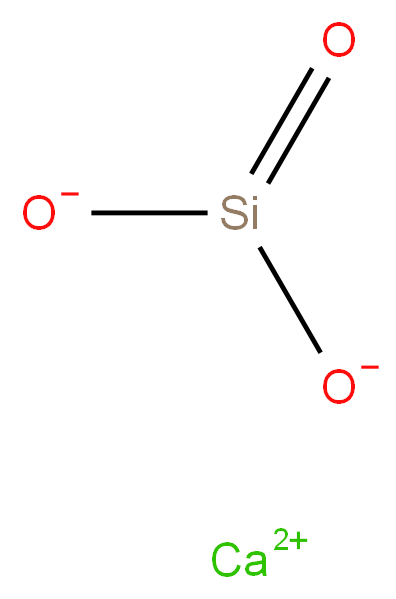Calcium metasilicate
- CAS NO.:13983-17-0
- Empirical Formula: CaO3Si
- Molecular Weight: 116.16
- MDL number: MFCD00015979
- EINECS: 237-772-5
- SAFETY DATA SHEET (SDS)
- Update Date: 2024-12-20 19:50:33

What is Calcium metasilicate?
Description
“Wollastonite” occurs as a calcium inosilicate
mineral that may contain small amounts of Fe, Mg and
Mn substituting for calcium.
The manufactured salt is
usually white. It forms within the earth when impure
limestone is subjected to high temperature and pressure,
sometimes in the presence of silica-bearing fluids as in
metamorphic rocks. It is named after the English
chemist and mineralogist William Wollaston (1766–
1828).
Wollastonite crystallizes as a triclinic crystal with
the space group, 1, and the lattice constants: a = 7.94? ,
b = 7.32 ? , c = 7.07 ? ; α= 90.03°, β = 95.37°, γ = 103.43°
and six formula units per cell.
Chemical properties
White to brown, red, gray, yellow solid; vitreous to pearly luster. Mohs hardness 4.5–5.
Physical properties
Wollastonite occurs as bladed crystal masses, single crystals can show an acicular particle shape and usually it exhibits a white color, but sometimes cream, gray or very pale green. The melting point of wollastonite is about 1540°C.
The Uses of Calcium metasilicate
Ceramics; paint extender; welding rod coatings; rubber filler; silica gels; paper coating; filler in plastics, cements, and wallboard; mineral wool; soil conditioner.
The Uses of Calcium metasilicate
Wollastonite is used primarily in ceramics, friction products (brakes and clutches), metalmaking, paint filler, and plastics.
Definition
A natural calcium silicate found in metamorphic rocks.
Production Methods
Wollastonite is a natural calcium silicate that typically occurs in deposits with other silicate minerals. When crushed, it tends to cleave into particles that have length to diameter ratios of 7 or 8 to 1. Fibrous forms of wollastonite are not uncommon.
General Description
White or slightly cream-colored powder. pH (aqueous slurry) 8.0 to 10.0.
Air & Water Reactions
Insoluble in water.
Reactivity Profile
These substances undergo chemical reactions only under relatively severe circumstances or in the presence of an effective catalyst that promotes reaction. They are resistant to ignition, although they may become flammable at very high temperatures. They will be resistant to oxidation/reduction, except in the most severe conditions. These materials may be nontoxic.
Hazard
Questionable carcinogen
Fire Hazard
Flash point data for CALCIUM SILICATE are not available; however, CALCIUM SILICATE is probably nonflammable.
Properties of Calcium metasilicate
| Melting point: | 1540°C |
| Density | 2,9 g/cm3 |
| refractive index | 1.62-1.64 |
| Stability: | Stable. |
| IARC | 3 (Vol. Sup 7, 68) 1997 |
| EPA Substance Registry System | Wollastonite (13983-17-0) |
Safety information for Calcium metasilicate
Computed Descriptors for Calcium metasilicate
New Products
Tert-butyl bis(2-chloroethyl)carbamate (S)-3-Aminobutanenitrile hydrochloride N-Boc-D-alaninol N-BOC-D/L-ALANINOL N-octanoyl benzotriazole 4-Hydrazinobenzoic acid 3,4-Dibenzyloxybenzaldehyde Electrolytic Iron Powder 1,1’-CARBONYLDIIMIDAZOLE R-2-BENZYLOXY PROPIONIC ACID 4-HYDROXY BENZYL ALCOHOL 1,1’-CARBONYLDI (1,2-4 TRIAZOLE) S-2-CHLORO PROPIONIC ACID (2-Hydroxyphenyl)acetonitrile 4-Bromopyrazole 5-BROMO-2CYANO PYRIDINE 5,6-Dimethoxyindanone 5-broMo-2-chloro-N-cyclopentylpyriMidin-4-aMine 3-(Hydroxymethyl)benzoate N-Boc-2-chloroethylamine 1-Bromo-2-methoxy-3-nitrobenzene N-Methyl-3-cyclopenten-1-amine 2-Bromo-3-hydroxybenzaldehyde 1H-indazole-5-carboxamideRelated products of tetrahydrofuran








You may like
-
 Wollastonite 99%View Details
Wollastonite 99%View Details -
 7441-43-2 98%View Details
7441-43-2 98%View Details
7441-43-2 -
 1260741-78-3 6-Bromo-3-iodo-1-methyl-1H-indazole 98%View Details
1260741-78-3 6-Bromo-3-iodo-1-methyl-1H-indazole 98%View Details
1260741-78-3 -
 4-bromo-3,5-dimethylbenzenesulfonyl chloride 1581266-79-6 98%View Details
4-bromo-3,5-dimethylbenzenesulfonyl chloride 1581266-79-6 98%View Details
1581266-79-6 -
 2490430-37-8 98%View Details
2490430-37-8 98%View Details
2490430-37-8 -
 N-(5-Amino-2-methylphenyl)acetamide 5434-30-0 98%View Details
N-(5-Amino-2-methylphenyl)acetamide 5434-30-0 98%View Details
5434-30-0 -
 124371-59-1 98%View Details
124371-59-1 98%View Details
124371-59-1 -
 53857-52-2 98%View Details
53857-52-2 98%View Details
53857-52-2